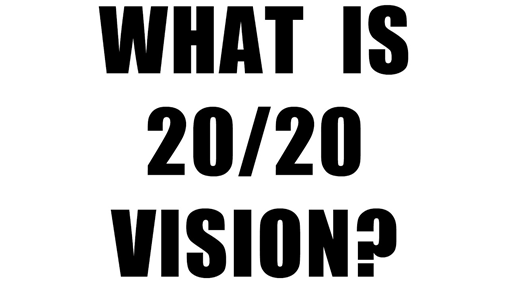
Vision 20/20 means a normal vision of a healthy eye. People having 20/20 vision are able to see an object situated at a distance of 20 feet away in a very clear manner.
Some people have 20/100 vision in which you have to stand as close to as 20 feet to the object whereas the normal eye i.e. people with 20/20 vision are able to see the same object placed at a distance of 100 feet. Having 20/20 vision does not mean that you have perfect vision. 20/20 vision only specifies the clarity and sharpness of your vision at a distance. Some important vision skills that are required to have a perfect vision are:
All these vision abilities contribute to your overall visual ability.
Some people are able to see things clearly placed at a certain distance but they’re not able to say see the same thing when they are placed nearby. This condition is caused by hyperopia (farsightedness) or presbyopia (loss of focusing ability). Similarly, there are some people who can see things clearly when placed nearby whereas they are not able to see the same thing when placed at a certain distance. This condition is caused by myopia (nearsightedness).
There are certain eye examinations conducted by the doctor to diagnose the issues present in your eyes. In most cases doctors prescribe eyeglasses or contact lenses to correct your vision problems or to help in improving them. If you have any vision problems because of an eye disease then you will be prescribed certain medications and ointments to cure them.
An eye test involves several tests to check the vision and check for eye diseases. Your eye doctor may use a variety of instruments like shine bright lights directly at your eyes i.e. known as slit lamp examination and request that you look through an array of lenses.
Visual Acuity Test
This test involves reading an eye chart. In which the size of the letters gradually decreases as you go down. This is the most common eye test to check your vision.
Retinoscopy
A machine called a phoropter is used by your ophthalmologist to conduct a retinoscopy, probably the thick machine you must have imagined sitting in front of while your ophthalmologist examines your eyes, with many dials and keys on it. A retinoscopy allows the ophthalmologist to estimate your optimal lens prescription. As you look into the machine the doctor changes the lens. You focus on a prominent object in front of you. Then the doctor uses a bright light i.e. also known slit lamp to look into your eyes and examine them properly.
Refraction Test
A refraction test examines your eyeglass prescription. You have to look at the eye chart on the opposite wall during this vision test.
Throughout the test, the doctor will put some lenses in front of your eyes. After switching the lens, the doctor will ask you questions like, which lens gave you a clearer vision or which lens reduced your eye strain. Based on the lens you were most comfortable with, your doctor will prescribe you the lens whether be it of near-sightedness or far-sightedness.
Peripheral Visual Field Test
While people tend to focus on whatever our eyes look directly at, we can also see objects on the sides of our visual field, also known as our peripheral vision. Visual field tests evaluate our peripheral vision.
Several types of peripheral visual field tests exist. They include the following:
You look into a special machine and focus on a spot in the center. You have to press a button whenever you see a light flash in your peripheral vision.
Make sure you visit your doctor immediately if you have any kind of difficulties like blurred vision or eye pain. Visit your doctor for regular check-ups as well.
Before the doctor performs any extra test with you, ask him/her about it.
Regular eye examinations are essential because:
An ophthalmologist may also be able to detect the symptoms of some bigger health conditions with symptoms that affect the eyes, such as diabetes and pressure. Eye examinations for children are vital to make sure that any visual difficulties such as squint, lazy eye, or short-sightedness are detected and treated early.
All these eye examinations are conducted to check whether your eyes are in perfect condition or not. If not then the doctor will tell you about the necessary things required by your eyes. Therefore, it is very important to go for a regular eye check-up. As there are cases in which a person is suffering from an eye disease but has no symptoms. These situations lead to severe conditions, harming the eyes in the worst ways.
Vision 20/20 does not mean a perfect vision; a person can have an eye problem even after having a 20/20 vision. 20/20 vision means the image that is formed in your retina is sharp and clear. The major solution for all the eye issues is prescribing eyeglass or contact lenses. But people who are suffering from an eye disease require certain medications and ointments to cure them. It is very important that you must go for your regular eye check-up so that you know whether your eyes are healthy or not.
To know more about it, you can easily visit our website Eyemantra. If you are looking for other services like cataract surgery, Retina surgery or Ocuploplasty you can simply ring at +91-9711115191. Even you can simply mail us on eyemantra1@gmail.com.
Related Links
How to Improve Vision Clarity: Tips to Prevent Everyday Habits